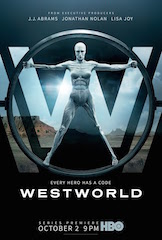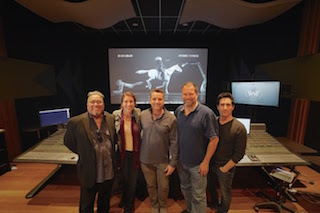 The drama series Westworld, which just completed its first season on HBO, is described as a dark odyssey about the dawn of artificial consciousness and the evolution of sin, exploring a world in which every human appetite, no matter how noble or depraved, can be indulged. One challenge for the producers was imagining how that world sounds.
The drama series Westworld, which just completed its first season on HBO, is described as a dark odyssey about the dawn of artificial consciousness and the evolution of sin, exploring a world in which every human appetite, no matter how noble or depraved, can be indulged. One challenge for the producers was imagining how that world sounds.
The contrast between (and sometimes intermingling of) the near future and the distant past fuels the drama and is a large part of the show’s fascinating appeal. Westworld’s sound team plays a significant role in conjuring up its two divergent worlds.
Re-recording mixers Keith Rogers and Scott Weber from South Lake Audio Services (which works out of Roundabout Entertainment in Burbank) were tasked with building soundtracks that include, on the one hand, steam locomotives, horses and gunfights, and, on the other, a vast industrial complex where engineers tinker with robots.
“That’s the joy of this show,” said producer Bruce Dunn, who supervises post-production. “We are truly working on two completely different genres in each episode, a full bore Western and a clinical, futuristic tech world. It’s a lot of fun to play with that as it moves back and forth, or, especially, when the two meld together.”
Other key members of the show’s sound team include Emmy-winning supervising sound editor Tom de Gorter from Atomic Sound and composer Ramin Djawadi. The final mix was completed on Roundabout’s Stage F.
 Rogers and Weber previously collaborated with Westworld co-creator and executive producer Jonathan Nolan on the series Person of Interest, and that familiarity helped them hit the ground running with Nolan and co-creator and executive producer Lisa Joy. “We’ve worked with Jonathan, Lisa, and their production team for more than five years and are in sync with their ideas and what they want to create in terms of a sonic image,” Rogers said. “Jonathan’s priority is storytelling, and he loves to use sound to support what he is trying to get across in his stories.”
Rogers and Weber previously collaborated with Westworld co-creator and executive producer Jonathan Nolan on the series Person of Interest, and that familiarity helped them hit the ground running with Nolan and co-creator and executive producer Lisa Joy. “We’ve worked with Jonathan, Lisa, and their production team for more than five years and are in sync with their ideas and what they want to create in terms of a sonic image,” Rogers said. “Jonathan’s priority is storytelling, and he loves to use sound to support what he is trying to get across in his stories.”
Citing the show’s length—most of the show’s ten episodes ran just under an hour—and the producers’ high expectations for quality, Rogers says the process of mixing Westworld is very demanding. But, he added, they also have more time than most television dramas with a full five days to deliver each episode. “Because we have time we treat each episode like a feature,” he said. “I pre-dub the dialogue, the ADR and the group elements before we add sound effects and music. That allows us to fine tune the elements. We are able to listen to each track, balance things and make sure they are correct. As we move forward, we balance the rest of the show around the dialogue.”
For the Old West scenes, de Gorter’s crew delivered a myriad of sound effects and sound design elements, many of which were originally recorded and derived from actual period sources. “There are authentic sounds of horses, wagons and guns,” said Weber. “There are no cars, so the ambience is birds and wind in the trees. In the bar, we have glass clinks and the crowds. It’s a lot of cool stuff.”
The soundscapes for the laboratory environments and not only far different, they require an imaginative touch in order to create a technological world, not of today, but of tomorrow. “The equipment needs to sound familiar but a little more advanced than what we have now,” said Dunn. “How does a robot sound? The first episode features a broken down, 35 year-old robot.
The sound team created sound treatments for an old robot’s eye blinks. They created tones for Tech World that vary from floor to floor, so Manufacturing sounds different from Behavior. There is a distinct sound for every place. If you listen to the mix closely, it’s all there.”
Rogers said they took pride in polishing the details. Many sounds play in the background and may go unnoticed, but are critical to creating a sense of place. “The subtleties are immense and it creates a lot of opportunities to experiment with sound,” he said. “It’s a sound designer’s dream.”
Westworld’s blending of two worlds poses unique challenges in the mix, said Weber, but he credits the producers for providing them with the latitude to succeed. “It’s a privilege to work with people who devote the time and resources to sound to ensure it is done right and sounds right,” he said. “They provide a great creative environment and the freedom to do our best work.”
